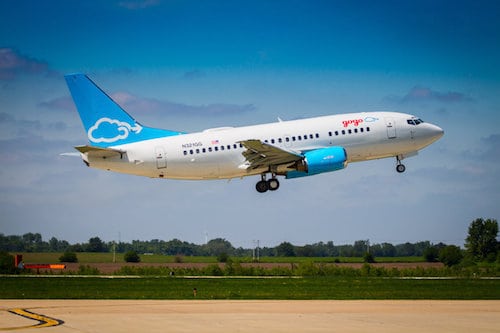
Photo courtesy of Gogo
Gogo announced Tuesday the completion of the first successful test flight of its next-generation air-to-ground (ATG) in-flight internet network. The Chicago-based company is part of a competitive field of airplane internet service providers working toward commercial service launches of next-generation networks designed to provide more capacity, higher bandwidth and faster in-flight connection speeds.
The network will have a peak capacity of more than 100 gbps, enabled by unlicensed spectrum in the 2.4 GHz spectrum band. It will also leverage spectrum from the first-generation Gogo ATG network, and the new network will be enabled by a new antenna and modem that Gogo claims will produce peak speeds of more than 100 mbps per aircraft. That connection speed is from Gogo’s network to the aircraft, with the actual speed experienced per passenger varying based on the type of internet activity. The new network becomes available next year.
But Gogo isn’t the only provider of internet service to commercial airliners and business jets that is progressing toward the operation of a new generation of its existing service. Inmarsat, Iridium, SmartSky, ViaSat and Yahsat are also in the process of transitioning to deployment of next-generation networks.
SmartSky, for example, provided demonstration flights allowing potential customers to use its 4G LTE network at NBAA 2017. The network is projected to become operational by mid-2018. The Charlotte, North Carolina-based company said that over three days, passengers on 12 flights experienced peak connection speeds in excess of 10 mbps.
Satellite service provider ViaSat, well known for its current speedy service featured across the entire fleet of JetBlue aircraft, is also moving to its next-generation network, ViaSat-2, in 2018. According to congressional testimony given by ViaSat CEO Mark Dankberg during a recent Senate commerce committee hearing analyzing the latest developments in commercial broadband satellite service, Dankberg noted that “more than two million personal electronic devices per month on airplanes” connect using ViaSat.
Iridium, meanwhile, is also in the process of launching its Iridium NEXT satellite constellation, with plans to enable higher speed data connections for commercial airliners, business jets and helicopters. The company is building 81 satellites for Iridium NEXT, with nine serving as on-orbit spares and six as ground spares. Regarding aircraft connectivity, Iridium is more focused on supporting cockpit communications, with CEO Matt Desch noting that the NEXT satellite constellation will support connection speeds of up to 700 kbps for its onboard Certus communications hardware.
In May, Inmarsat introduced the commercial service of its new Ka-band broadband service, GX Aviation, with launch customer Lufthansa. The U.K.-based satellite service provider is also in the process of completing the first flight trials for its European Aviation Network (EAN). Inmarsat calls EAN the first dedicated network to combine space- and ground-based components for in-flight broadband service. The network consists of Inmarsat’s EAN satellite, which completed in-orbit tests last month and a complimentary network of 300 LTE-based ground stations operated by Deutsche Telekom.
Meanwhile in the Middle East, United Arab Emirates (UAE)-based satellite operator Yahsat announced the first successful trial of a 50 Mbps in-flight internet connection using its “Al Yah 2” Ka-band satellite. Yahsat has not yet said when its next-generation in-flight broadband service will become commercially available.
And new networks with more bandwidth and higher connection speeds are needed, especially for commercial airlines flying aircraft equipped with older generation technology. According to Cisco’s 2017 mobile data traffic forecast, global mobile data traffic reached an average of 7.2 exabytes per month in 2016, and mobile video traffic accounted for 60% of total mobile traffic last year. The majority of today’s commercial airliners are equipped with internet service incapable to supporting mobile video, with some exceptions. For example, Gogo includes a notice when access to its service is purchased on American Airlines, warning passengers that streaming video is not supported.
A July Inmarsat survey of 9,000 airline passengers from 18 countries across Asia Pacific, Europe, the Middle East and North America found that 60% of respondents believe in-flight Wi-Fi is a necessity, and 61% rate “high quality in-flight Wi-Fi” as more important than onboard entertainment.
According to Gogo, when its next-generation ATG network comes online in 2018 in combination with its new 2Ku satellite solution, the company will have the “highest capacity network ever built that’s dedicated to serving aviation.”